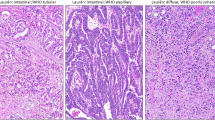Abstract
The purpose of this paper is to assess the clinical and histopathological significance of tumors at the esophago-gastric junction (EGJ). The biological behaviour of these tumors was studied, with regard to the infiltrative pattern and mitotic index, in 15 patients with tumors at the EGJ. Twenty-seven tumors at the cardia, with or without esophageal invasion, were chosen for DNA analysis at their most proximal and deepest apexes. The esophageal and gastric apexes of the tumors had the same infiltrative pattern in 14 out of 15 cases and this tendency was not altered with further stratification of the anatomical layers. In comparing the deviations of the stem lines, the relative frequency of nuclei with DNA over 4n and 6n and aneuploid from the DNA histograms between the esophageal and the deepest apexes of the tumor revealed no statistically significant differences, depending on esophageal invasion. From these results, the specificities of EGJ toward tumor invasion or activity were not regarded as consequential, and the EGJ couldn't be regarded as a barrier against tumor invasion.
Similar content being viewed by others
References
Allison PR. Resection of the cardia and lower esophagus. Proc R Soc Med 1946; 39: 415–419.
McPeak E, Warren S. Histological features of carcinoma of the cardio-esophageal junction and cardia. Amer J Path 1948; 24: 971–1001.
Dodge OG. The surgical pathology of gastro-esophageal carcinoma. Brit J Surg 1961; 121–125.
The General Rules for the Gastric Cancer Study in Surgery and Pathology. Japanese Research Society for Gastric Cancer. Jpn J Surg 1981; 11: 127–139.
Iwase Z. A study on a new microspectrophotometry of nuclear DNA by means of cell isolation from fixed tissues and its application for gastric cancer and other gastric lesions. Medical Journal of Osaka University Japanese Edition 1971; 23: 243–264. (English Abst.)
Sprenger E, Witte S. The diagnostic significance of flow cytometrical nuclear DNA measurement in gastroscopic diagnosis of the stomach. Path Res Pract 1976; 163: 148–157.
Ishikawa M, Okajima K, Fujii Y, Narusue M, Araki K, Tsuboi A, Okabayashi K, Ueda Y, Kitayama Y, Tanaka Y. Study on cardiac carcinoma-referring to esophageal extension. Geka (Surgery) 1977; 39: 853–857. (in Japanese)
Mori K. Bronchoesophageal lymphatics. Nippon Kikan Syokudo Kagakukai Kaiho (J Jpn Bronchoesophageal Soc) 1968; 19: 85–99. (English Abst.)
Nishi M, Kasaji T, Suenaga T, Azuma G, Nomura H, Aikou T, Matsuno M, Tanaka T. Specificities of carcinoma at the esophago-gastric junction. Shujutsu (Operation) 1978; 32: 827–833. (in Japanese)
Minami E. Relation of mitotic activity to various pathological findings in human colorectal carcinoma. Kobe Daigaku Igakubu Kiyō (Kobe J Med Sci) 1982; 28: 19–32 (English Abst.)
Tabuchi Y, Inoue K, Minami Y, Boku S, Kato M, Takiguchi Y, Murayama Y, Kawaguchi K, Mitsuno T. A study on mitotic activity of human gastric carcinoma treated with vincristine sulfate. J J Surg 1980; 81: 306–316.
Fulker MJ, Cooper EH, Tanaka T. Proliferation and ultrastructure of papillary transitional cell carcinoma of the bladder. Cancer 1971; 27: 71–82.
Aherne NB, Buck P. The potential cell population doubling time in neuroblastoma and nephroblastoma. Brit J Cancer 1971; 25: 691–696.
Yoshida A. Nuclear DNA content of thyroid adenocarcinoma. Nippon Geka Gakkai Zasshi (J Jpn Surg Soc) 1984; 85: 1261–1273. (English Abst.)
Lieb L, Lisco H.In vitro uptake of tritiated thymidine by carcinoma of the human colon. Cancer Res 1966; 26: 733–740.
Wattenburg LW. Histochemical study of five oxidative enzymes in carcinoma of the large intestine in man. Am J Pathol 1959; 35: 113–137.
Atkins NB. Modal DNA value and chromosome number in ovarian neoplasia. A clinical and histopathological assessment. Cancer 1971; 27: 1064–1073.
Goto H, Ide K, Jojima T, Manabe Y, Suda T, Yoshida A, Kure Y, Yokoyama H. Papillary adenocarcinoma of thyroid-significance of tracheal invasion. Shujutsu (Operation) 1981; 35: 887–893. (in Japanese)
Author information
Authors and Affiliations
Rights and permissions
About this article
Cite this article
Noguchi, Y., Imada, T. & Matsumoto, A. Carcinoma at the esophago-gastric junction —Its biological behaviour toward the squamous epithelium—. The Japanese Journal of Surgery 19, 143–152 (1989). https://doi.org/10.1007/BF02471578
Received:
Issue Date:
DOI: https://doi.org/10.1007/BF02471578




